Analysis of Digital Communication Strategy in Tourism
VerifiedAdded on 2021/04/05
|21
|4756
|374
AI Summary
The assignment requires an analysis of the digital communication strategy used by the Hong Kong Tourism Board, including their website, social media pages, and YouTube channel. It also involves a comprehensive review of the literature on mobile technology use in hospitality and tourism, as well as an examination of relevant studies on digital communication strategies in tourism. The assignment aims to provide insights into the effective use of digital channels for tourism promotion and engagement.
Contribute Materials
Your contribution can guide someone’s learning journey. Share your
documents today.

University of Sunderland
Name: Yee Lok Lai
STU: 179116845
Program: BSc(Hons) International Tourism and Hospitality Management(Top-up)
Module: TLH 342 Digital Technologies In The Visitor Economy
Word Count: 3110 words
A Winter Season Digital Communication Strategy of Hong Kong
1.0 Introduction 2
2.0 Background Information 2
3.0 Literature Review 3
4.0 Case Study 6
5.0 Discussion and Conclusion 9
Reference 10
Appendices 14
1
Name: Yee Lok Lai
STU: 179116845
Program: BSc(Hons) International Tourism and Hospitality Management(Top-up)
Module: TLH 342 Digital Technologies In The Visitor Economy
Word Count: 3110 words
A Winter Season Digital Communication Strategy of Hong Kong
1.0 Introduction 2
2.0 Background Information 2
3.0 Literature Review 3
4.0 Case Study 6
5.0 Discussion and Conclusion 9
Reference 10
Appendices 14
1
Secure Best Marks with AI Grader
Need help grading? Try our AI Grader for instant feedback on your assignments.

1.0 Introduction
The advancement of information and communication technology has led to the rise of the need to
access faster information. Governments, organizations, institutions, and individuals continue
demanding quick information, which has led to the rapid growth of digital communications and
the need for revolutions in this field in order to fulfill demand. Contemporary organizations
employ a wide range of online channels that range from website to mobile to blogs in order to
connect with prospective and current employees, customers, and other stakeholders. Notably,
modern businesses need digital marketing professionals with a keen understanding of how to
leverage the convergence of contemporary technology and message to their advantages. Reports
have shown that the use of digital has made a critical shift in how information is consumed and
distributed as such, digital communication promises for possibilities of cost-effective methods
that engage numerous stakeholders and prompt better public understanding of communication
and science.
2.0 Background Information
According to a recent study conducted by Martinez-Sanz (2012, pp. n. p), the internet provides
individuals with the ability to communicate at a large distance and cover a Wide Area Network
(WAN). The ability has, in recent years, expanded the role of network and includes information
sharing through internet-supported sites such as social media and has been enhanced by the
innovation of devices such as computers and mobile phones. Indeed, in the contemporary world
driven by technology, social networking sites such as Facebook, Twitter, and other platforms
have become the main avenue where salespeople, retailers, and businesses extend their
marketing and other related campaigns to much wider consumers than before. Tarute, Nikou, and
Gatautis (2017, pp. 146) define social media as a group of applications based on the internet and
build on the Web's technological and ideological foundations. On the same note, Bicen and
Kocakoyun (2017, pp. 20) point out that social media allow the exchange and creation of
user-generated content. In the modern era, social media use through different platforms has
become a part of humans’ everyday life in both their professional and private environments.
Some of the social media uses include data exchange, communication, and the distribution of
advertisements and news (Jothi, Neelamalar, and Prasad, 2011, 236). On the other hand, Mobile
devices have become more useful and have increased in the last two decades allowing
2
The advancement of information and communication technology has led to the rise of the need to
access faster information. Governments, organizations, institutions, and individuals continue
demanding quick information, which has led to the rapid growth of digital communications and
the need for revolutions in this field in order to fulfill demand. Contemporary organizations
employ a wide range of online channels that range from website to mobile to blogs in order to
connect with prospective and current employees, customers, and other stakeholders. Notably,
modern businesses need digital marketing professionals with a keen understanding of how to
leverage the convergence of contemporary technology and message to their advantages. Reports
have shown that the use of digital has made a critical shift in how information is consumed and
distributed as such, digital communication promises for possibilities of cost-effective methods
that engage numerous stakeholders and prompt better public understanding of communication
and science.
2.0 Background Information
According to a recent study conducted by Martinez-Sanz (2012, pp. n. p), the internet provides
individuals with the ability to communicate at a large distance and cover a Wide Area Network
(WAN). The ability has, in recent years, expanded the role of network and includes information
sharing through internet-supported sites such as social media and has been enhanced by the
innovation of devices such as computers and mobile phones. Indeed, in the contemporary world
driven by technology, social networking sites such as Facebook, Twitter, and other platforms
have become the main avenue where salespeople, retailers, and businesses extend their
marketing and other related campaigns to much wider consumers than before. Tarute, Nikou, and
Gatautis (2017, pp. 146) define social media as a group of applications based on the internet and
build on the Web's technological and ideological foundations. On the same note, Bicen and
Kocakoyun (2017, pp. 20) point out that social media allow the exchange and creation of
user-generated content. In the modern era, social media use through different platforms has
become a part of humans’ everyday life in both their professional and private environments.
Some of the social media uses include data exchange, communication, and the distribution of
advertisements and news (Jothi, Neelamalar, and Prasad, 2011, 236). On the other hand, Mobile
devices have become more useful and have increased in the last two decades allowing
2

individuals to execute more and different tasks in a mobile context. According to Stoyanov,
Hides, Kavanagh, and Wilson (2016, pp. 72), a mobile application also known as an app refers to
unique software that is designed to run on mobile devices such as tablet computers and
smartphones. Mobile applications server to provide users with services similar to those accessed
on PCs. As these mobile devices are designed to enable individuals to use them while mobile has
made the impact of these devices on the users’ mobility, a critical factor to the failure or success
of the application. In Hong Kong, social media platforms such as Instagram, Whatsapp,
Facebook, and Twitter have operated freely despite being blocked in China’s mainland under the
Great Firewall. According to some studies, technology companies, including Google, TikTok,
Facebook, Twitter, WhatsApp, Zoom, and Telegram, have enjoyed Hong Kong’s fastest speeds.
3.0 Literature Review
A comparison of the literature review conducted in the past consisted of a review and
identification and online searches of key influences of social media and mobile technology.
Reports have shown that it is more likely to see cyclists in the city riding along the streets while
texting. On the same note, it is common to hear public announcements warning people to keep
their eyes off their mobile phones while riding an escalator. These, among other reports, show
that the consumption of smartphones is deep-rooted and has become a culture among the locals
in the city. In another study, Au and Ho (2019, pp. 17) point out that businesses are taking
advantage of social media as a vehicle of outreach. The businesses are heavily involved in social
media platforms where they engage consumers and advertise their products.
According to a survey conducted by TNS, Facebook was the most used social network in the
city, with 50% of the population, which was about 4.4 million users in 2014 (Su and Chan, 2017,
pp. 259). The study found that most of the Facebook users considered the site as their first
contact point when reading breaking news. Additionally, it was found that more than 3.1 million
individuals log into their Facebook account every day and spend at least 30 minutes on the site
every time they visit. According to Socialbakers, a social media statistic provider, the largest
Facebook's users across the city were aged between 25 and 34 years, followed by the cohort of
18 to 24 years, with both groups having females as the dominating users (Antoniadis, Paltsoglou,
Vasios, and Kyratsis, 2020, pp. 366). Stone and Wang (2019, pp. 776) digital outreach as
3
Hides, Kavanagh, and Wilson (2016, pp. 72), a mobile application also known as an app refers to
unique software that is designed to run on mobile devices such as tablet computers and
smartphones. Mobile applications server to provide users with services similar to those accessed
on PCs. As these mobile devices are designed to enable individuals to use them while mobile has
made the impact of these devices on the users’ mobility, a critical factor to the failure or success
of the application. In Hong Kong, social media platforms such as Instagram, Whatsapp,
Facebook, and Twitter have operated freely despite being blocked in China’s mainland under the
Great Firewall. According to some studies, technology companies, including Google, TikTok,
Facebook, Twitter, WhatsApp, Zoom, and Telegram, have enjoyed Hong Kong’s fastest speeds.
3.0 Literature Review
A comparison of the literature review conducted in the past consisted of a review and
identification and online searches of key influences of social media and mobile technology.
Reports have shown that it is more likely to see cyclists in the city riding along the streets while
texting. On the same note, it is common to hear public announcements warning people to keep
their eyes off their mobile phones while riding an escalator. These, among other reports, show
that the consumption of smartphones is deep-rooted and has become a culture among the locals
in the city. In another study, Au and Ho (2019, pp. 17) point out that businesses are taking
advantage of social media as a vehicle of outreach. The businesses are heavily involved in social
media platforms where they engage consumers and advertise their products.
According to a survey conducted by TNS, Facebook was the most used social network in the
city, with 50% of the population, which was about 4.4 million users in 2014 (Su and Chan, 2017,
pp. 259). The study found that most of the Facebook users considered the site as their first
contact point when reading breaking news. Additionally, it was found that more than 3.1 million
individuals log into their Facebook account every day and spend at least 30 minutes on the site
every time they visit. According to Socialbakers, a social media statistic provider, the largest
Facebook's users across the city were aged between 25 and 34 years, followed by the cohort of
18 to 24 years, with both groups having females as the dominating users (Antoniadis, Paltsoglou,
Vasios, and Kyratsis, 2020, pp. 366). Stone and Wang (2019, pp. 776) digital outreach as
3

possessing capabilities or changing the way individuals engage in issues, especially through
social media. As the number of individuals who access information and data from social media
platforms continues to increase, the role of social media vehicles in shaping people’s opinions
will become increasingly significant. On the same note, two studies explore the influence of
social media on people’s opinions. To examine the role of YouTube in Climategate, Sopu,
Chisaki, and Usagawa (2016, pp. 210) employ a multi-determinant framework. On the other
hand, Lim, Wright, Carrotte, and Pedrana (2017, pp. 189)provide a study that attempts to explore
the role of social media in influencing youths in political disaffection. Both studies insist on
contextualizing research by use of social media data. For instance, Lim, Wright, Carrotte, and
Pedrana (2017, pp. 189) noted that social media consumers were more likely to become
disaffected and cynical on campaigns. On the other hand, consumers who express themselves
online are more likely to be skeptical and easily to be better informed as they are persuaded
through additional information. Both Lim, Wright, Carrotte, and Pedrana (2017, pp. 189) and
Sopu, Chisaki, and Usagawa (2016, pp. 210) present results that underscore the growing need of
conducting further studies to understand better the dynamics of how individuals perceive
information from online sources. The authors point out that relying on one-dimensional
indicators may be insufficient predictors.
As a result of recent advancements in mobile technology, individual daily lifestyles are changing
exorbitantly from the fact that smartphone penetration and use is on the rise. According to Niu
and Ho (2014, pp. 2671), the majority of human life aspects are becoming very dependent on
mobile technology, thus increasing demand for better software necessary for running mobile
devices. Software developers prompt to produce high-quality mobile applications in order to
sustain the growing demand for mobile technology (LeFevre et al. 2017, pp. 27). Larger
applications like Weibo may need more attention, bigger budgets, and expansive resources
compared to minute applications whose usage is still within the usual demand limits. Research
studies are being done to highlight the more reasonable estimations between mobile app
development and application testing. A similar Systematic Literature Review (SLR) is applied in
this paper to highlight the comprehensive application software testing and development
estimation process. In his recent study, Law, Chan, and Wang (2018, pp. 629) argue that agile
4
social media. As the number of individuals who access information and data from social media
platforms continues to increase, the role of social media vehicles in shaping people’s opinions
will become increasingly significant. On the same note, two studies explore the influence of
social media on people’s opinions. To examine the role of YouTube in Climategate, Sopu,
Chisaki, and Usagawa (2016, pp. 210) employ a multi-determinant framework. On the other
hand, Lim, Wright, Carrotte, and Pedrana (2017, pp. 189)provide a study that attempts to explore
the role of social media in influencing youths in political disaffection. Both studies insist on
contextualizing research by use of social media data. For instance, Lim, Wright, Carrotte, and
Pedrana (2017, pp. 189) noted that social media consumers were more likely to become
disaffected and cynical on campaigns. On the other hand, consumers who express themselves
online are more likely to be skeptical and easily to be better informed as they are persuaded
through additional information. Both Lim, Wright, Carrotte, and Pedrana (2017, pp. 189) and
Sopu, Chisaki, and Usagawa (2016, pp. 210) present results that underscore the growing need of
conducting further studies to understand better the dynamics of how individuals perceive
information from online sources. The authors point out that relying on one-dimensional
indicators may be insufficient predictors.
As a result of recent advancements in mobile technology, individual daily lifestyles are changing
exorbitantly from the fact that smartphone penetration and use is on the rise. According to Niu
and Ho (2014, pp. 2671), the majority of human life aspects are becoming very dependent on
mobile technology, thus increasing demand for better software necessary for running mobile
devices. Software developers prompt to produce high-quality mobile applications in order to
sustain the growing demand for mobile technology (LeFevre et al. 2017, pp. 27). Larger
applications like Weibo may need more attention, bigger budgets, and expansive resources
compared to minute applications whose usage is still within the usual demand limits. Research
studies are being done to highlight the more reasonable estimations between mobile app
development and application testing. A similar Systematic Literature Review (SLR) is applied in
this paper to highlight the comprehensive application software testing and development
estimation process. In his recent study, Law, Chan, and Wang (2018, pp. 629) argue that agile
4
Secure Best Marks with AI Grader
Need help grading? Try our AI Grader for instant feedback on your assignments.
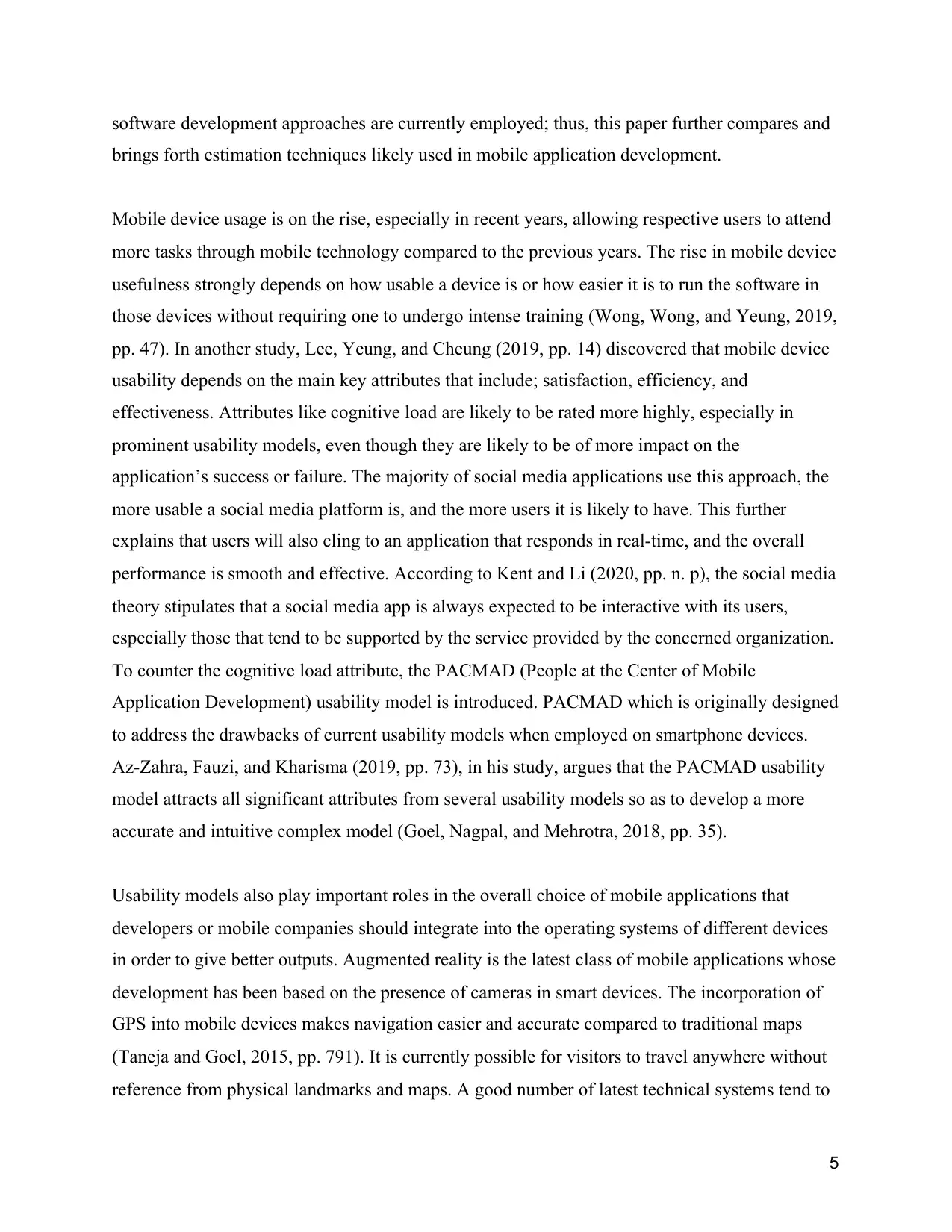
software development approaches are currently employed; thus, this paper further compares and
brings forth estimation techniques likely used in mobile application development.
Mobile device usage is on the rise, especially in recent years, allowing respective users to attend
more tasks through mobile technology compared to the previous years. The rise in mobile device
usefulness strongly depends on how usable a device is or how easier it is to run the software in
those devices without requiring one to undergo intense training (Wong, Wong, and Yeung, 2019,
pp. 47). In another study, Lee, Yeung, and Cheung (2019, pp. 14) discovered that mobile device
usability depends on the main key attributes that include; satisfaction, efficiency, and
effectiveness. Attributes like cognitive load are likely to be rated more highly, especially in
prominent usability models, even though they are likely to be of more impact on the
application’s success or failure. The majority of social media applications use this approach, the
more usable a social media platform is, and the more users it is likely to have. This further
explains that users will also cling to an application that responds in real-time, and the overall
performance is smooth and effective. According to Kent and Li (2020, pp. n. p), the social media
theory stipulates that a social media app is always expected to be interactive with its users,
especially those that tend to be supported by the service provided by the concerned organization.
To counter the cognitive load attribute, the PACMAD (People at the Center of Mobile
Application Development) usability model is introduced. PACMAD which is originally designed
to address the drawbacks of current usability models when employed on smartphone devices.
Az-Zahra, Fauzi, and Kharisma (2019, pp. 73), in his study, argues that the PACMAD usability
model attracts all significant attributes from several usability models so as to develop a more
accurate and intuitive complex model (Goel, Nagpal, and Mehrotra, 2018, pp. 35).
Usability models also play important roles in the overall choice of mobile applications that
developers or mobile companies should integrate into the operating systems of different devices
in order to give better outputs. Augmented reality is the latest class of mobile applications whose
development has been based on the presence of cameras in smart devices. The incorporation of
GPS into mobile devices makes navigation easier and accurate compared to traditional maps
(Taneja and Goel, 2015, pp. 791). It is currently possible for visitors to travel anywhere without
reference from physical landmarks and maps. A good number of latest technical systems tend to
5
brings forth estimation techniques likely used in mobile application development.
Mobile device usage is on the rise, especially in recent years, allowing respective users to attend
more tasks through mobile technology compared to the previous years. The rise in mobile device
usefulness strongly depends on how usable a device is or how easier it is to run the software in
those devices without requiring one to undergo intense training (Wong, Wong, and Yeung, 2019,
pp. 47). In another study, Lee, Yeung, and Cheung (2019, pp. 14) discovered that mobile device
usability depends on the main key attributes that include; satisfaction, efficiency, and
effectiveness. Attributes like cognitive load are likely to be rated more highly, especially in
prominent usability models, even though they are likely to be of more impact on the
application’s success or failure. The majority of social media applications use this approach, the
more usable a social media platform is, and the more users it is likely to have. This further
explains that users will also cling to an application that responds in real-time, and the overall
performance is smooth and effective. According to Kent and Li (2020, pp. n. p), the social media
theory stipulates that a social media app is always expected to be interactive with its users,
especially those that tend to be supported by the service provided by the concerned organization.
To counter the cognitive load attribute, the PACMAD (People at the Center of Mobile
Application Development) usability model is introduced. PACMAD which is originally designed
to address the drawbacks of current usability models when employed on smartphone devices.
Az-Zahra, Fauzi, and Kharisma (2019, pp. 73), in his study, argues that the PACMAD usability
model attracts all significant attributes from several usability models so as to develop a more
accurate and intuitive complex model (Goel, Nagpal, and Mehrotra, 2018, pp. 35).
Usability models also play important roles in the overall choice of mobile applications that
developers or mobile companies should integrate into the operating systems of different devices
in order to give better outputs. Augmented reality is the latest class of mobile applications whose
development has been based on the presence of cameras in smart devices. The incorporation of
GPS into mobile devices makes navigation easier and accurate compared to traditional maps
(Taneja and Goel, 2015, pp. 791). It is currently possible for visitors to travel anywhere without
reference from physical landmarks and maps. A good number of latest technical systems tend to
5

use tactile feedback to offer assistance to clients. Similarly, users interact by allowing feedback
notifications to reach them through alert messages or vibrations. Devices alert users in terms of
which direction to follow or where there is a possibility of coming across obstacles in the course
of navigation.
4.0 Case Study
Insights from these pieces of literature could be useful in designing website features and content.
The use of social media and mobile applications in Hong Kong has been a part of their lives in
both professional and private environments. Hong Kong residents use social media for data
exchange, communication, and distribution of advertisements and news. On the other hand, there
are more than 9580 apps from the city’s publishers on Google play. According to a study
conducted by Doris (2015, pp. 49), 65% of all apps released by publishers in Hong Kong are
apps while the rest are games. This statistic shows that people from the city focus more on apps
over games. Therefore, the consumption of social media and mobile apps will continue growing
and will most likely hit the peak during the 2020 winter.
Hong Kong Tourism Board and Mobile Applications
Hong Kong Tourism Board
The Hong Kong Tourism Board (HKTB) is a government-subvented body tasked to market and
promote Hong Kong as a travel destination worldwide and to enhance visitors' experience once
they arrive. (About Us | Hong Kong Tourism Board, 2020) There are six objectives of the
HKTB, which include endeavor to increase the contribution of tourism to Hong Kong, promote
Hong Kong globally as a leading international city in Asia and a world-class tourist destination,
promote the improvement of facilities for visitors, support the Government in promoting to the
community the importance of tourism, support, as appropriate, the activities of persons providing
services for visitors to Hong Kong; and make recommendations to and advise the Chief
Executive (of the Hong Kong Special Administrative Region) in relation to any measures which
may be taken to further any of the foregoing matters. (Corporate Information | Hong Kong
Tourism Board, 2020)
6
notifications to reach them through alert messages or vibrations. Devices alert users in terms of
which direction to follow or where there is a possibility of coming across obstacles in the course
of navigation.
4.0 Case Study
Insights from these pieces of literature could be useful in designing website features and content.
The use of social media and mobile applications in Hong Kong has been a part of their lives in
both professional and private environments. Hong Kong residents use social media for data
exchange, communication, and distribution of advertisements and news. On the other hand, there
are more than 9580 apps from the city’s publishers on Google play. According to a study
conducted by Doris (2015, pp. 49), 65% of all apps released by publishers in Hong Kong are
apps while the rest are games. This statistic shows that people from the city focus more on apps
over games. Therefore, the consumption of social media and mobile apps will continue growing
and will most likely hit the peak during the 2020 winter.
Hong Kong Tourism Board and Mobile Applications
Hong Kong Tourism Board
The Hong Kong Tourism Board (HKTB) is a government-subvented body tasked to market and
promote Hong Kong as a travel destination worldwide and to enhance visitors' experience once
they arrive. (About Us | Hong Kong Tourism Board, 2020) There are six objectives of the
HKTB, which include endeavor to increase the contribution of tourism to Hong Kong, promote
Hong Kong globally as a leading international city in Asia and a world-class tourist destination,
promote the improvement of facilities for visitors, support the Government in promoting to the
community the importance of tourism, support, as appropriate, the activities of persons providing
services for visitors to Hong Kong; and make recommendations to and advise the Chief
Executive (of the Hong Kong Special Administrative Region) in relation to any measures which
may be taken to further any of the foregoing matters. (Corporate Information | Hong Kong
Tourism Board, 2020)
6
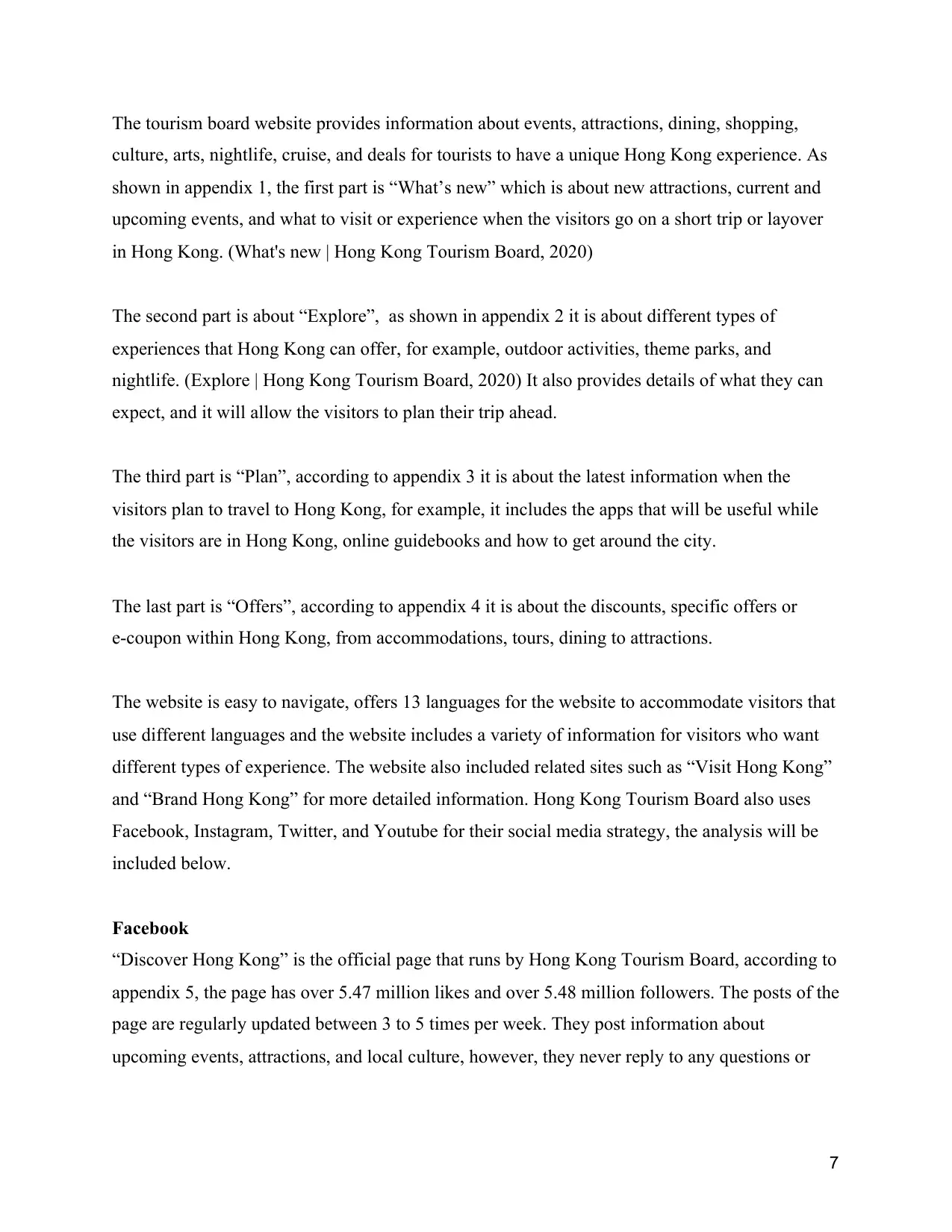
The tourism board website provides information about events, attractions, dining, shopping,
culture, arts, nightlife, cruise, and deals for tourists to have a unique Hong Kong experience. As
shown in appendix 1, the first part is “What’s new” which is about new attractions, current and
upcoming events, and what to visit or experience when the visitors go on a short trip or layover
in Hong Kong. (What's new | Hong Kong Tourism Board, 2020)
The second part is about “Explore”, as shown in appendix 2 it is about different types of
experiences that Hong Kong can offer, for example, outdoor activities, theme parks, and
nightlife. (Explore | Hong Kong Tourism Board, 2020) It also provides details of what they can
expect, and it will allow the visitors to plan their trip ahead.
The third part is “Plan”, according to appendix 3 it is about the latest information when the
visitors plan to travel to Hong Kong, for example, it includes the apps that will be useful while
the visitors are in Hong Kong, online guidebooks and how to get around the city.
The last part is “Offers”, according to appendix 4 it is about the discounts, specific offers or
e-coupon within Hong Kong, from accommodations, tours, dining to attractions.
The website is easy to navigate, offers 13 languages for the website to accommodate visitors that
use different languages and the website includes a variety of information for visitors who want
different types of experience. The website also included related sites such as “Visit Hong Kong”
and “Brand Hong Kong” for more detailed information. Hong Kong Tourism Board also uses
Facebook, Instagram, Twitter, and Youtube for their social media strategy, the analysis will be
included below.
Facebook
“Discover Hong Kong” is the official page that runs by Hong Kong Tourism Board, according to
appendix 5, the page has over 5.47 million likes and over 5.48 million followers. The posts of the
page are regularly updated between 3 to 5 times per week. They post information about
upcoming events, attractions, and local culture, however, they never reply to any questions or
7
culture, arts, nightlife, cruise, and deals for tourists to have a unique Hong Kong experience. As
shown in appendix 1, the first part is “What’s new” which is about new attractions, current and
upcoming events, and what to visit or experience when the visitors go on a short trip or layover
in Hong Kong. (What's new | Hong Kong Tourism Board, 2020)
The second part is about “Explore”, as shown in appendix 2 it is about different types of
experiences that Hong Kong can offer, for example, outdoor activities, theme parks, and
nightlife. (Explore | Hong Kong Tourism Board, 2020) It also provides details of what they can
expect, and it will allow the visitors to plan their trip ahead.
The third part is “Plan”, according to appendix 3 it is about the latest information when the
visitors plan to travel to Hong Kong, for example, it includes the apps that will be useful while
the visitors are in Hong Kong, online guidebooks and how to get around the city.
The last part is “Offers”, according to appendix 4 it is about the discounts, specific offers or
e-coupon within Hong Kong, from accommodations, tours, dining to attractions.
The website is easy to navigate, offers 13 languages for the website to accommodate visitors that
use different languages and the website includes a variety of information for visitors who want
different types of experience. The website also included related sites such as “Visit Hong Kong”
and “Brand Hong Kong” for more detailed information. Hong Kong Tourism Board also uses
Facebook, Instagram, Twitter, and Youtube for their social media strategy, the analysis will be
included below.
“Discover Hong Kong” is the official page that runs by Hong Kong Tourism Board, according to
appendix 5, the page has over 5.47 million likes and over 5.48 million followers. The posts of the
page are regularly updated between 3 to 5 times per week. They post information about
upcoming events, attractions, and local culture, however, they never reply to any questions or
7
Paraphrase This Document
Need a fresh take? Get an instant paraphrase of this document with our AI Paraphraser
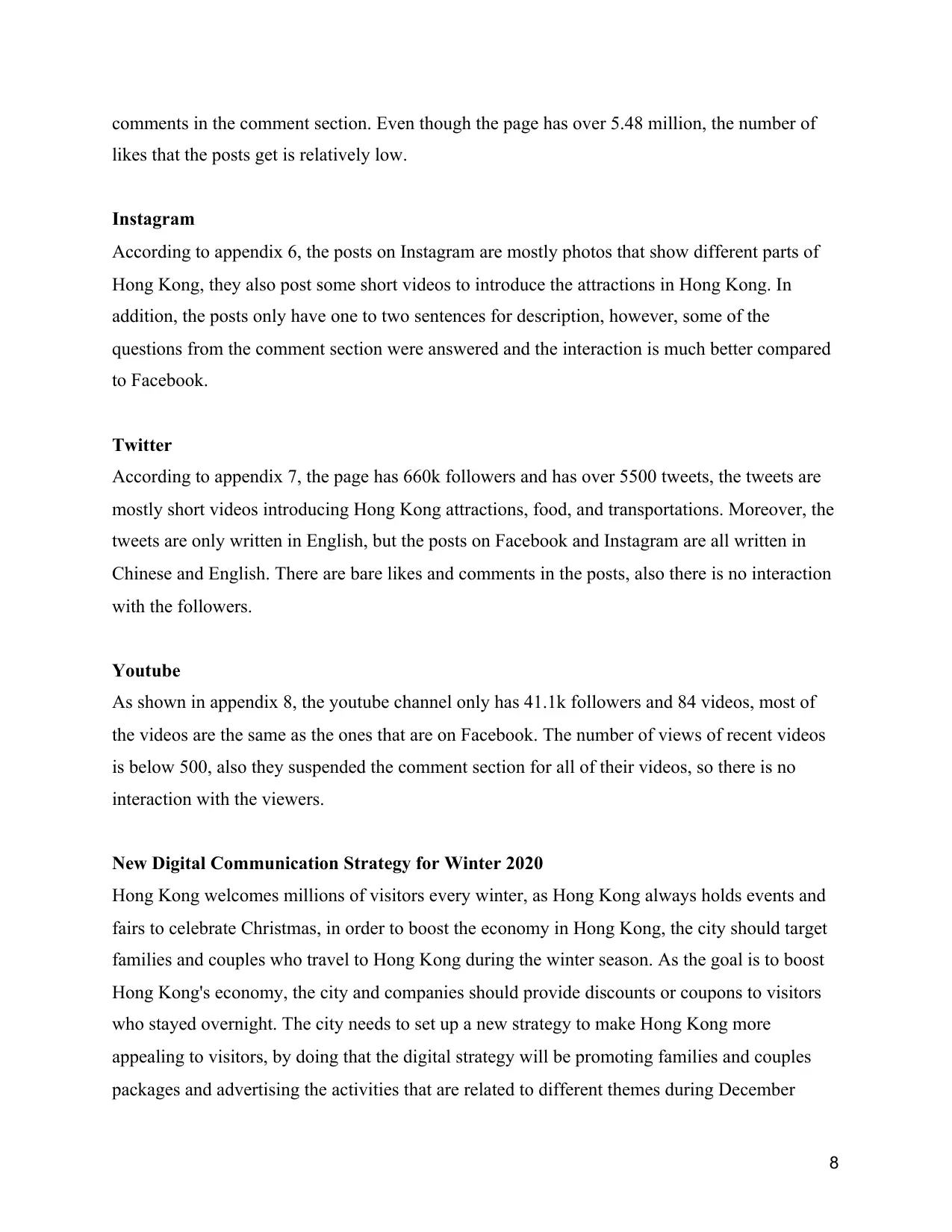
comments in the comment section. Even though the page has over 5.48 million, the number of
likes that the posts get is relatively low.
Instagram
According to appendix 6, the posts on Instagram are mostly photos that show different parts of
Hong Kong, they also post some short videos to introduce the attractions in Hong Kong. In
addition, the posts only have one to two sentences for description, however, some of the
questions from the comment section were answered and the interaction is much better compared
to Facebook.
Twitter
According to appendix 7, the page has 660k followers and has over 5500 tweets, the tweets are
mostly short videos introducing Hong Kong attractions, food, and transportations. Moreover, the
tweets are only written in English, but the posts on Facebook and Instagram are all written in
Chinese and English. There are bare likes and comments in the posts, also there is no interaction
with the followers.
Youtube
As shown in appendix 8, the youtube channel only has 41.1k followers and 84 videos, most of
the videos are the same as the ones that are on Facebook. The number of views of recent videos
is below 500, also they suspended the comment section for all of their videos, so there is no
interaction with the viewers.
New Digital Communication Strategy for Winter 2020
Hong Kong welcomes millions of visitors every winter, as Hong Kong always holds events and
fairs to celebrate Christmas, in order to boost the economy in Hong Kong, the city should target
families and couples who travel to Hong Kong during the winter season. As the goal is to boost
Hong Kong's economy, the city and companies should provide discounts or coupons to visitors
who stayed overnight. The city needs to set up a new strategy to make Hong Kong more
appealing to visitors, by doing that the digital strategy will be promoting families and couples
packages and advertising the activities that are related to different themes during December
8
likes that the posts get is relatively low.
According to appendix 6, the posts on Instagram are mostly photos that show different parts of
Hong Kong, they also post some short videos to introduce the attractions in Hong Kong. In
addition, the posts only have one to two sentences for description, however, some of the
questions from the comment section were answered and the interaction is much better compared
to Facebook.
According to appendix 7, the page has 660k followers and has over 5500 tweets, the tweets are
mostly short videos introducing Hong Kong attractions, food, and transportations. Moreover, the
tweets are only written in English, but the posts on Facebook and Instagram are all written in
Chinese and English. There are bare likes and comments in the posts, also there is no interaction
with the followers.
Youtube
As shown in appendix 8, the youtube channel only has 41.1k followers and 84 videos, most of
the videos are the same as the ones that are on Facebook. The number of views of recent videos
is below 500, also they suspended the comment section for all of their videos, so there is no
interaction with the viewers.
New Digital Communication Strategy for Winter 2020
Hong Kong welcomes millions of visitors every winter, as Hong Kong always holds events and
fairs to celebrate Christmas, in order to boost the economy in Hong Kong, the city should target
families and couples who travel to Hong Kong during the winter season. As the goal is to boost
Hong Kong's economy, the city and companies should provide discounts or coupons to visitors
who stayed overnight. The city needs to set up a new strategy to make Hong Kong more
appealing to visitors, by doing that the digital strategy will be promoting families and couples
packages and advertising the activities that are related to different themes during December
8
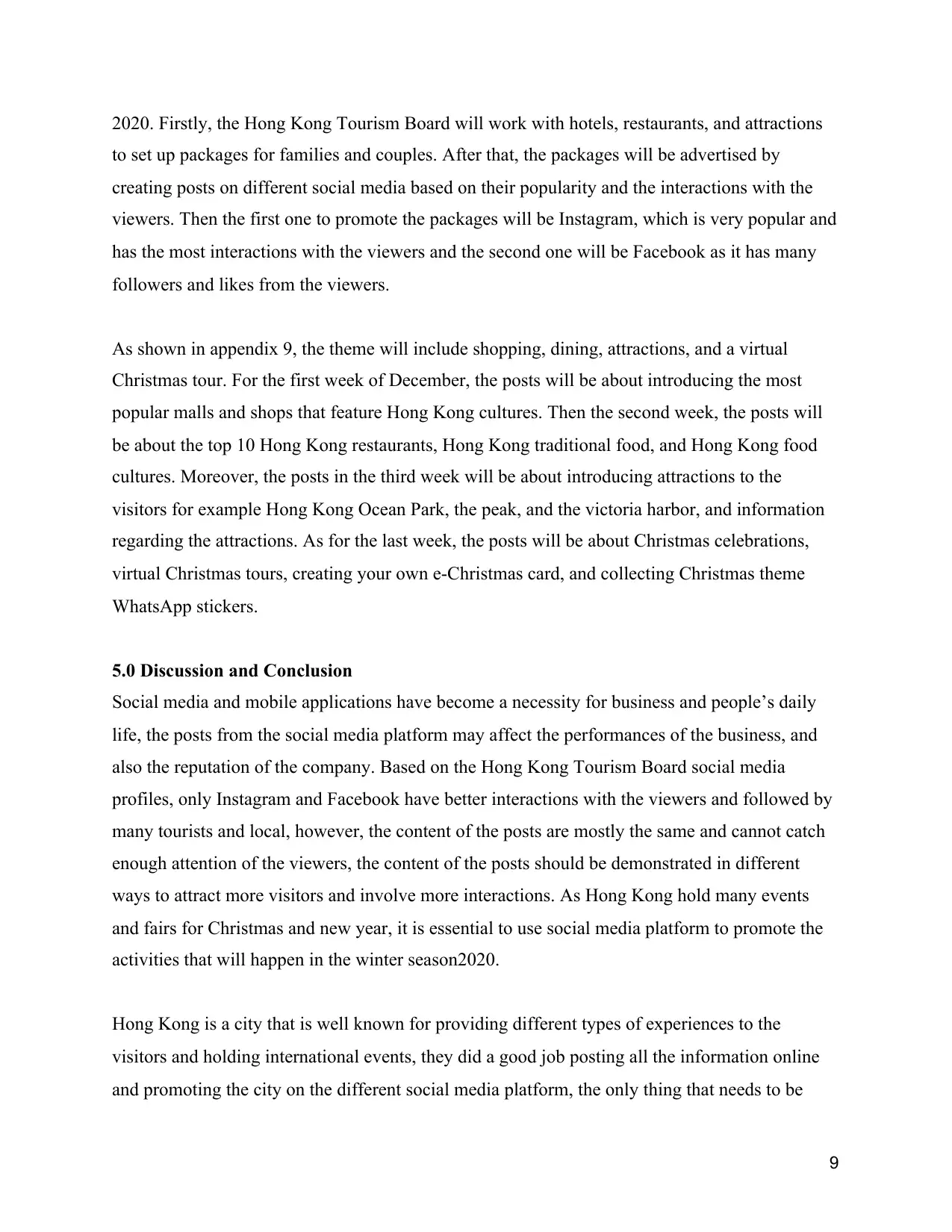
2020. Firstly, the Hong Kong Tourism Board will work with hotels, restaurants, and attractions
to set up packages for families and couples. After that, the packages will be advertised by
creating posts on different social media based on their popularity and the interactions with the
viewers. Then the first one to promote the packages will be Instagram, which is very popular and
has the most interactions with the viewers and the second one will be Facebook as it has many
followers and likes from the viewers.
As shown in appendix 9, the theme will include shopping, dining, attractions, and a virtual
Christmas tour. For the first week of December, the posts will be about introducing the most
popular malls and shops that feature Hong Kong cultures. Then the second week, the posts will
be about the top 10 Hong Kong restaurants, Hong Kong traditional food, and Hong Kong food
cultures. Moreover, the posts in the third week will be about introducing attractions to the
visitors for example Hong Kong Ocean Park, the peak, and the victoria harbor, and information
regarding the attractions. As for the last week, the posts will be about Christmas celebrations,
virtual Christmas tours, creating your own e-Christmas card, and collecting Christmas theme
WhatsApp stickers.
5.0 Discussion and Conclusion
Social media and mobile applications have become a necessity for business and people’s daily
life, the posts from the social media platform may affect the performances of the business, and
also the reputation of the company. Based on the Hong Kong Tourism Board social media
profiles, only Instagram and Facebook have better interactions with the viewers and followed by
many tourists and local, however, the content of the posts are mostly the same and cannot catch
enough attention of the viewers, the content of the posts should be demonstrated in different
ways to attract more visitors and involve more interactions. As Hong Kong hold many events
and fairs for Christmas and new year, it is essential to use social media platform to promote the
activities that will happen in the winter season2020.
Hong Kong is a city that is well known for providing different types of experiences to the
visitors and holding international events, they did a good job posting all the information online
and promoting the city on the different social media platform, the only thing that needs to be
9
to set up packages for families and couples. After that, the packages will be advertised by
creating posts on different social media based on their popularity and the interactions with the
viewers. Then the first one to promote the packages will be Instagram, which is very popular and
has the most interactions with the viewers and the second one will be Facebook as it has many
followers and likes from the viewers.
As shown in appendix 9, the theme will include shopping, dining, attractions, and a virtual
Christmas tour. For the first week of December, the posts will be about introducing the most
popular malls and shops that feature Hong Kong cultures. Then the second week, the posts will
be about the top 10 Hong Kong restaurants, Hong Kong traditional food, and Hong Kong food
cultures. Moreover, the posts in the third week will be about introducing attractions to the
visitors for example Hong Kong Ocean Park, the peak, and the victoria harbor, and information
regarding the attractions. As for the last week, the posts will be about Christmas celebrations,
virtual Christmas tours, creating your own e-Christmas card, and collecting Christmas theme
WhatsApp stickers.
5.0 Discussion and Conclusion
Social media and mobile applications have become a necessity for business and people’s daily
life, the posts from the social media platform may affect the performances of the business, and
also the reputation of the company. Based on the Hong Kong Tourism Board social media
profiles, only Instagram and Facebook have better interactions with the viewers and followed by
many tourists and local, however, the content of the posts are mostly the same and cannot catch
enough attention of the viewers, the content of the posts should be demonstrated in different
ways to attract more visitors and involve more interactions. As Hong Kong hold many events
and fairs for Christmas and new year, it is essential to use social media platform to promote the
activities that will happen in the winter season2020.
Hong Kong is a city that is well known for providing different types of experiences to the
visitors and holding international events, they did a good job posting all the information online
and promoting the city on the different social media platform, the only thing that needs to be
9

improved is there are not enough interactions between the Hong Kong Tourism Board and the
viewers, which will affect the visitors’ decision when they plan their visit, by improving the level
of interaction, more visitors be attracted.
10
viewers, which will affect the visitors’ decision when they plan their visit, by improving the level
of interaction, more visitors be attracted.
10
Secure Best Marks with AI Grader
Need help grading? Try our AI Grader for instant feedback on your assignments.
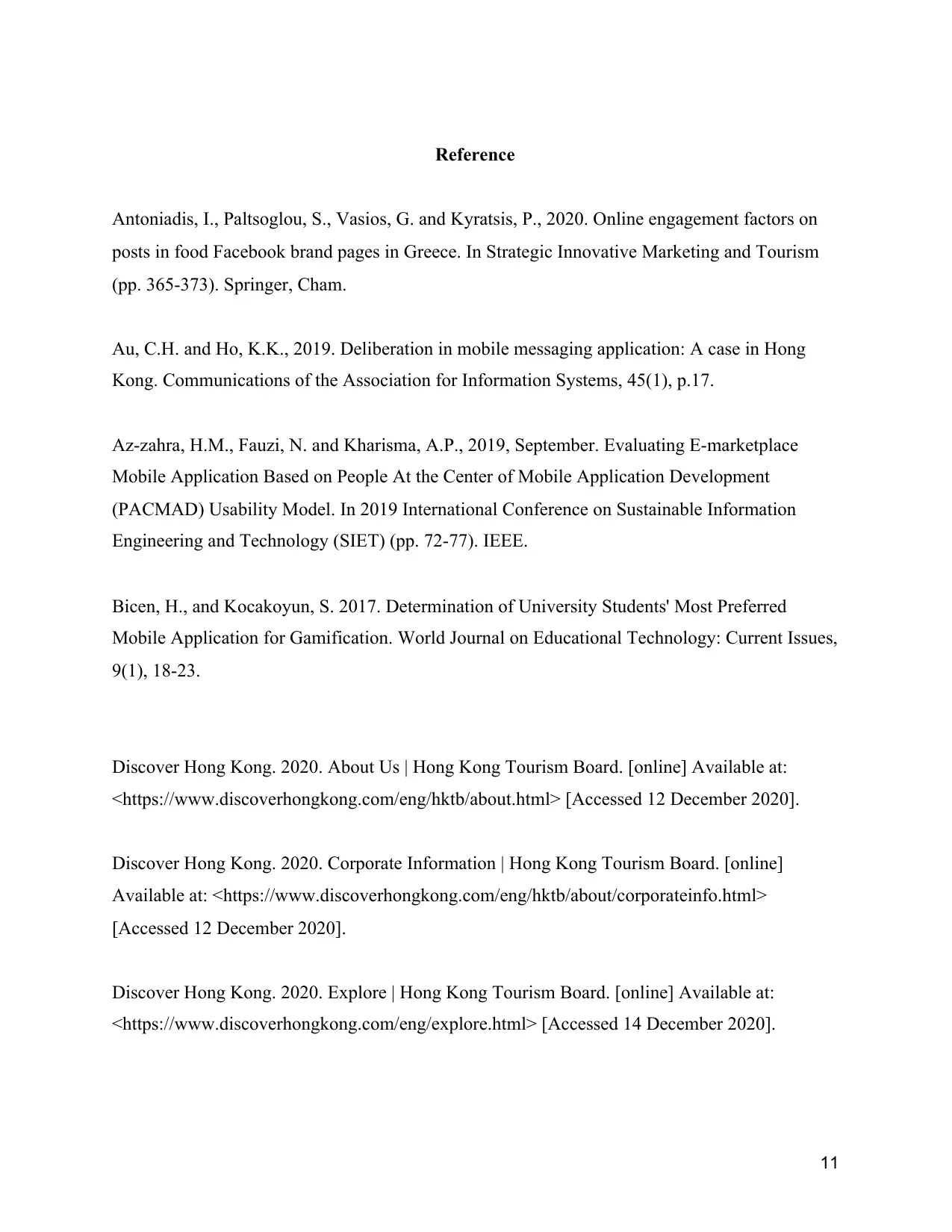
Reference
Antoniadis, I., Paltsoglou, S., Vasios, G. and Kyratsis, P., 2020. Online engagement factors on
posts in food Facebook brand pages in Greece. In Strategic Innovative Marketing and Tourism
(pp. 365-373). Springer, Cham.
Au, C.H. and Ho, K.K., 2019. Deliberation in mobile messaging application: A case in Hong
Kong. Communications of the Association for Information Systems, 45(1), p.17.
Az-zahra, H.M., Fauzi, N. and Kharisma, A.P., 2019, September. Evaluating E-marketplace
Mobile Application Based on People At the Center of Mobile Application Development
(PACMAD) Usability Model. In 2019 International Conference on Sustainable Information
Engineering and Technology (SIET) (pp. 72-77). IEEE.
Bicen, H., and Kocakoyun, S. 2017. Determination of University Students' Most Preferred
Mobile Application for Gamification. World Journal on Educational Technology: Current Issues,
9(1), 18-23.
Discover Hong Kong. 2020. About Us | Hong Kong Tourism Board. [online] Available at:
<https://www.discoverhongkong.com/eng/hktb/about.html> [Accessed 12 December 2020].
Discover Hong Kong. 2020. Corporate Information | Hong Kong Tourism Board. [online]
Available at: <https://www.discoverhongkong.com/eng/hktb/about/corporateinfo.html>
[Accessed 12 December 2020].
Discover Hong Kong. 2020. Explore | Hong Kong Tourism Board. [online] Available at:
<https://www.discoverhongkong.com/eng/explore.html> [Accessed 14 December 2020].
11
Antoniadis, I., Paltsoglou, S., Vasios, G. and Kyratsis, P., 2020. Online engagement factors on
posts in food Facebook brand pages in Greece. In Strategic Innovative Marketing and Tourism
(pp. 365-373). Springer, Cham.
Au, C.H. and Ho, K.K., 2019. Deliberation in mobile messaging application: A case in Hong
Kong. Communications of the Association for Information Systems, 45(1), p.17.
Az-zahra, H.M., Fauzi, N. and Kharisma, A.P., 2019, September. Evaluating E-marketplace
Mobile Application Based on People At the Center of Mobile Application Development
(PACMAD) Usability Model. In 2019 International Conference on Sustainable Information
Engineering and Technology (SIET) (pp. 72-77). IEEE.
Bicen, H., and Kocakoyun, S. 2017. Determination of University Students' Most Preferred
Mobile Application for Gamification. World Journal on Educational Technology: Current Issues,
9(1), 18-23.
Discover Hong Kong. 2020. About Us | Hong Kong Tourism Board. [online] Available at:
<https://www.discoverhongkong.com/eng/hktb/about.html> [Accessed 12 December 2020].
Discover Hong Kong. 2020. Corporate Information | Hong Kong Tourism Board. [online]
Available at: <https://www.discoverhongkong.com/eng/hktb/about/corporateinfo.html>
[Accessed 12 December 2020].
Discover Hong Kong. 2020. Explore | Hong Kong Tourism Board. [online] Available at:
<https://www.discoverhongkong.com/eng/explore.html> [Accessed 14 December 2020].
11
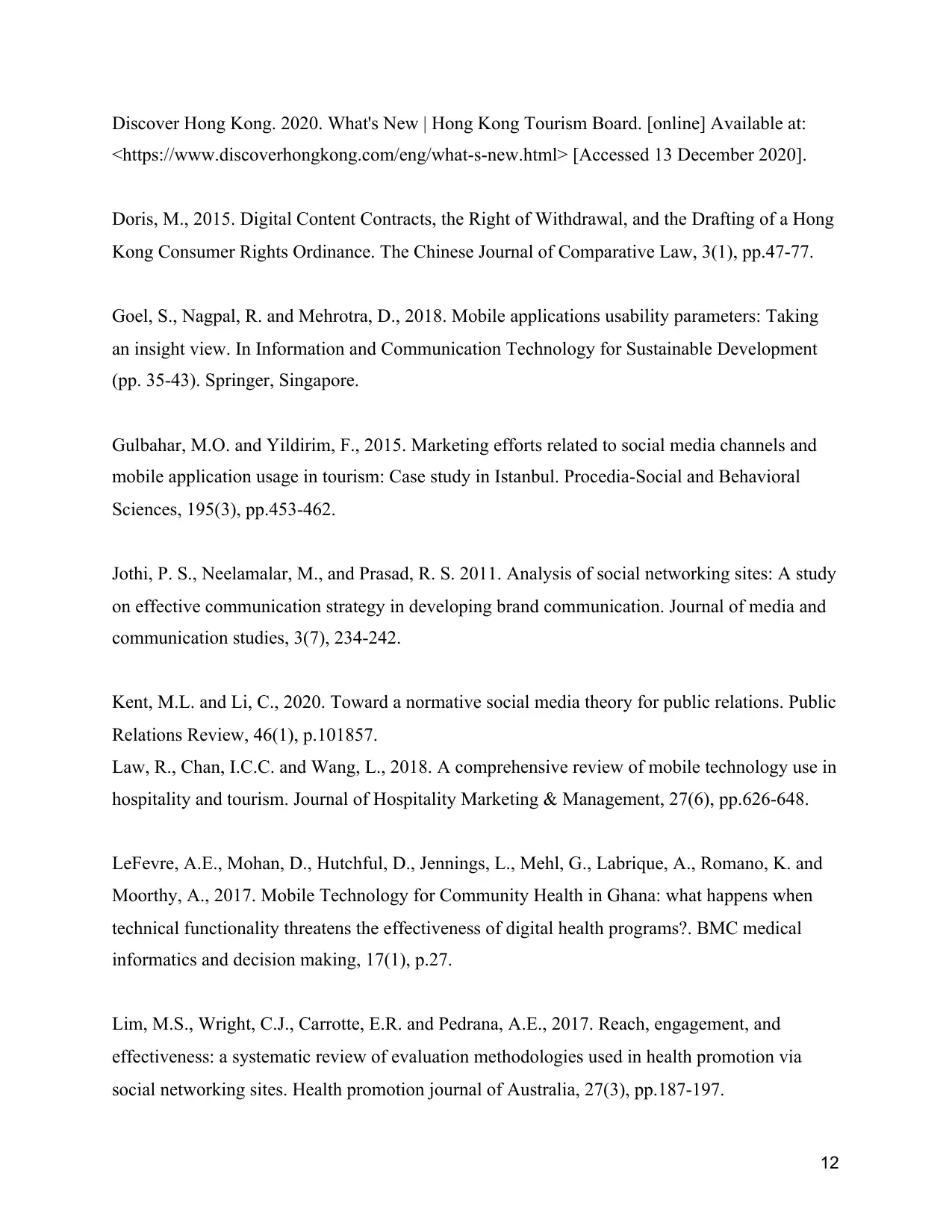
Discover Hong Kong. 2020. What's New | Hong Kong Tourism Board. [online] Available at:
<https://www.discoverhongkong.com/eng/what-s-new.html> [Accessed 13 December 2020].
Doris, M., 2015. Digital Content Contracts, the Right of Withdrawal, and the Drafting of a Hong
Kong Consumer Rights Ordinance. The Chinese Journal of Comparative Law, 3(1), pp.47-77.
Goel, S., Nagpal, R. and Mehrotra, D., 2018. Mobile applications usability parameters: Taking
an insight view. In Information and Communication Technology for Sustainable Development
(pp. 35-43). Springer, Singapore.
Gulbahar, M.O. and Yildirim, F., 2015. Marketing efforts related to social media channels and
mobile application usage in tourism: Case study in Istanbul. Procedia-Social and Behavioral
Sciences, 195(3), pp.453-462.
Jothi, P. S., Neelamalar, M., and Prasad, R. S. 2011. Analysis of social networking sites: A study
on effective communication strategy in developing brand communication. Journal of media and
communication studies, 3(7), 234-242.
Kent, M.L. and Li, C., 2020. Toward a normative social media theory for public relations. Public
Relations Review, 46(1), p.101857.
Law, R., Chan, I.C.C. and Wang, L., 2018. A comprehensive review of mobile technology use in
hospitality and tourism. Journal of Hospitality Marketing & Management, 27(6), pp.626-648.
LeFevre, A.E., Mohan, D., Hutchful, D., Jennings, L., Mehl, G., Labrique, A., Romano, K. and
Moorthy, A., 2017. Mobile Technology for Community Health in Ghana: what happens when
technical functionality threatens the effectiveness of digital health programs?. BMC medical
informatics and decision making, 17(1), p.27.
Lim, M.S., Wright, C.J., Carrotte, E.R. and Pedrana, A.E., 2017. Reach, engagement, and
effectiveness: a systematic review of evaluation methodologies used in health promotion via
social networking sites. Health promotion journal of Australia, 27(3), pp.187-197.
12
<https://www.discoverhongkong.com/eng/what-s-new.html> [Accessed 13 December 2020].
Doris, M., 2015. Digital Content Contracts, the Right of Withdrawal, and the Drafting of a Hong
Kong Consumer Rights Ordinance. The Chinese Journal of Comparative Law, 3(1), pp.47-77.
Goel, S., Nagpal, R. and Mehrotra, D., 2018. Mobile applications usability parameters: Taking
an insight view. In Information and Communication Technology for Sustainable Development
(pp. 35-43). Springer, Singapore.
Gulbahar, M.O. and Yildirim, F., 2015. Marketing efforts related to social media channels and
mobile application usage in tourism: Case study in Istanbul. Procedia-Social and Behavioral
Sciences, 195(3), pp.453-462.
Jothi, P. S., Neelamalar, M., and Prasad, R. S. 2011. Analysis of social networking sites: A study
on effective communication strategy in developing brand communication. Journal of media and
communication studies, 3(7), 234-242.
Kent, M.L. and Li, C., 2020. Toward a normative social media theory for public relations. Public
Relations Review, 46(1), p.101857.
Law, R., Chan, I.C.C. and Wang, L., 2018. A comprehensive review of mobile technology use in
hospitality and tourism. Journal of Hospitality Marketing & Management, 27(6), pp.626-648.
LeFevre, A.E., Mohan, D., Hutchful, D., Jennings, L., Mehl, G., Labrique, A., Romano, K. and
Moorthy, A., 2017. Mobile Technology for Community Health in Ghana: what happens when
technical functionality threatens the effectiveness of digital health programs?. BMC medical
informatics and decision making, 17(1), p.27.
Lim, M.S., Wright, C.J., Carrotte, E.R. and Pedrana, A.E., 2017. Reach, engagement, and
effectiveness: a systematic review of evaluation methodologies used in health promotion via
social networking sites. Health promotion journal of Australia, 27(3), pp.187-197.
12
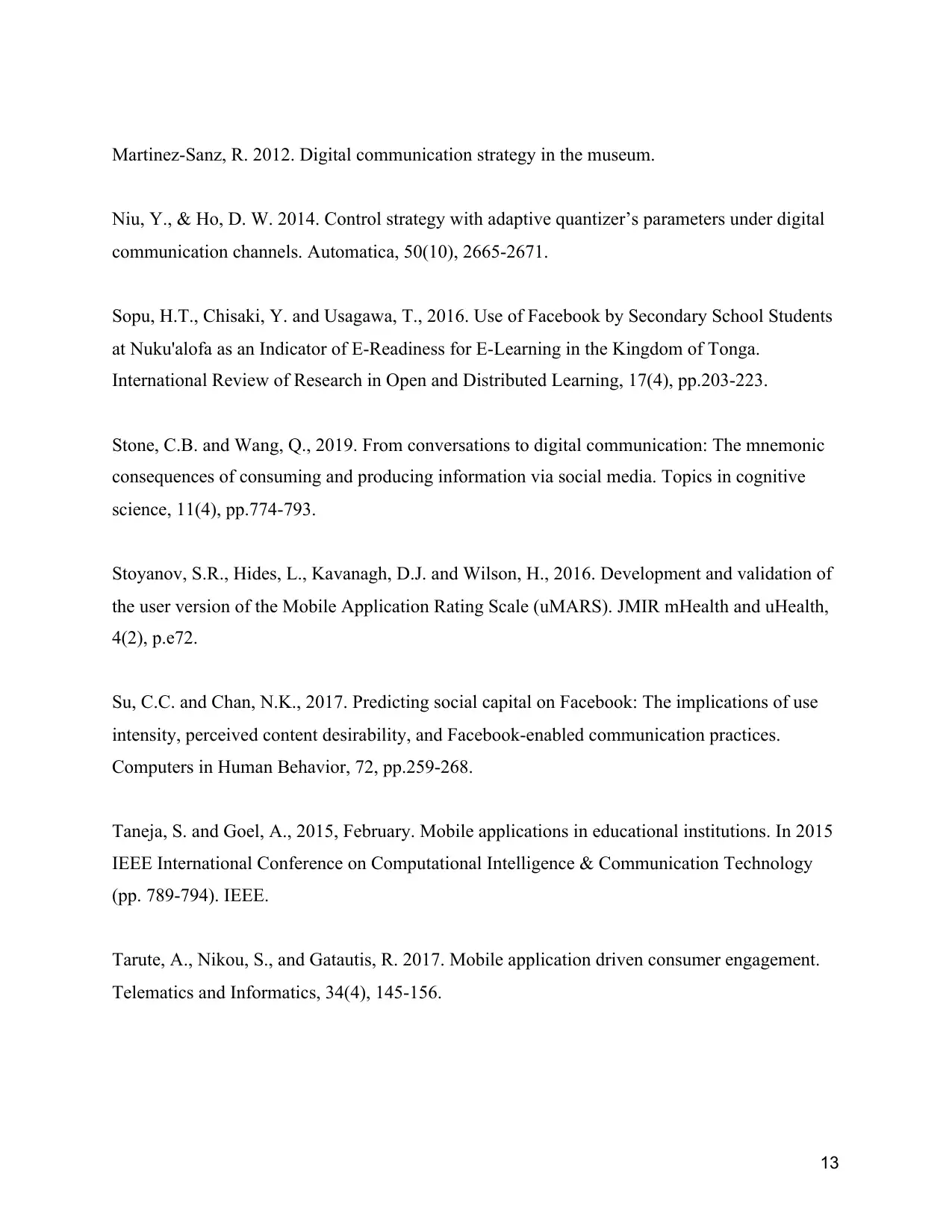
Martinez-Sanz, R. 2012. Digital communication strategy in the museum.
Niu, Y., & Ho, D. W. 2014. Control strategy with adaptive quantizer’s parameters under digital
communication channels. Automatica, 50(10), 2665-2671.
Sopu, H.T., Chisaki, Y. and Usagawa, T., 2016. Use of Facebook by Secondary School Students
at Nuku'alofa as an Indicator of E-Readiness for E-Learning in the Kingdom of Tonga.
International Review of Research in Open and Distributed Learning, 17(4), pp.203-223.
Stone, C.B. and Wang, Q., 2019. From conversations to digital communication: The mnemonic
consequences of consuming and producing information via social media. Topics in cognitive
science, 11(4), pp.774-793.
Stoyanov, S.R., Hides, L., Kavanagh, D.J. and Wilson, H., 2016. Development and validation of
the user version of the Mobile Application Rating Scale (uMARS). JMIR mHealth and uHealth,
4(2), p.e72.
Su, C.C. and Chan, N.K., 2017. Predicting social capital on Facebook: The implications of use
intensity, perceived content desirability, and Facebook-enabled communication practices.
Computers in Human Behavior, 72, pp.259-268.
Taneja, S. and Goel, A., 2015, February. Mobile applications in educational institutions. In 2015
IEEE International Conference on Computational Intelligence & Communication Technology
(pp. 789-794). IEEE.
Tarute, A., Nikou, S., and Gatautis, R. 2017. Mobile application driven consumer engagement.
Telematics and Informatics, 34(4), 145-156.
13
Niu, Y., & Ho, D. W. 2014. Control strategy with adaptive quantizer’s parameters under digital
communication channels. Automatica, 50(10), 2665-2671.
Sopu, H.T., Chisaki, Y. and Usagawa, T., 2016. Use of Facebook by Secondary School Students
at Nuku'alofa as an Indicator of E-Readiness for E-Learning in the Kingdom of Tonga.
International Review of Research in Open and Distributed Learning, 17(4), pp.203-223.
Stone, C.B. and Wang, Q., 2019. From conversations to digital communication: The mnemonic
consequences of consuming and producing information via social media. Topics in cognitive
science, 11(4), pp.774-793.
Stoyanov, S.R., Hides, L., Kavanagh, D.J. and Wilson, H., 2016. Development and validation of
the user version of the Mobile Application Rating Scale (uMARS). JMIR mHealth and uHealth,
4(2), p.e72.
Su, C.C. and Chan, N.K., 2017. Predicting social capital on Facebook: The implications of use
intensity, perceived content desirability, and Facebook-enabled communication practices.
Computers in Human Behavior, 72, pp.259-268.
Taneja, S. and Goel, A., 2015, February. Mobile applications in educational institutions. In 2015
IEEE International Conference on Computational Intelligence & Communication Technology
(pp. 789-794). IEEE.
Tarute, A., Nikou, S., and Gatautis, R. 2017. Mobile application driven consumer engagement.
Telematics and Informatics, 34(4), 145-156.
13
Paraphrase This Document
Need a fresh take? Get an instant paraphrase of this document with our AI Paraphraser

Wong, S., Wong, A. and Yeung, J., 2019. Exploring Students’ Acceptance of Using Mobile
Device-based Student Response System in Classrooms. Journal of Interactive Learning
Research, 30(1), pp.45-64.
Appendices
Appendix 1
14
Device-based Student Response System in Classrooms. Journal of Interactive Learning
Research, 30(1), pp.45-64.
Appendices
Appendix 1
14

“What’s new” in Hong Kong Tourism Board website
Appendix 2
“Explore” in Hong Kong Tourism Board
Appendix 3
15
Appendix 2
“Explore” in Hong Kong Tourism Board
Appendix 3
15
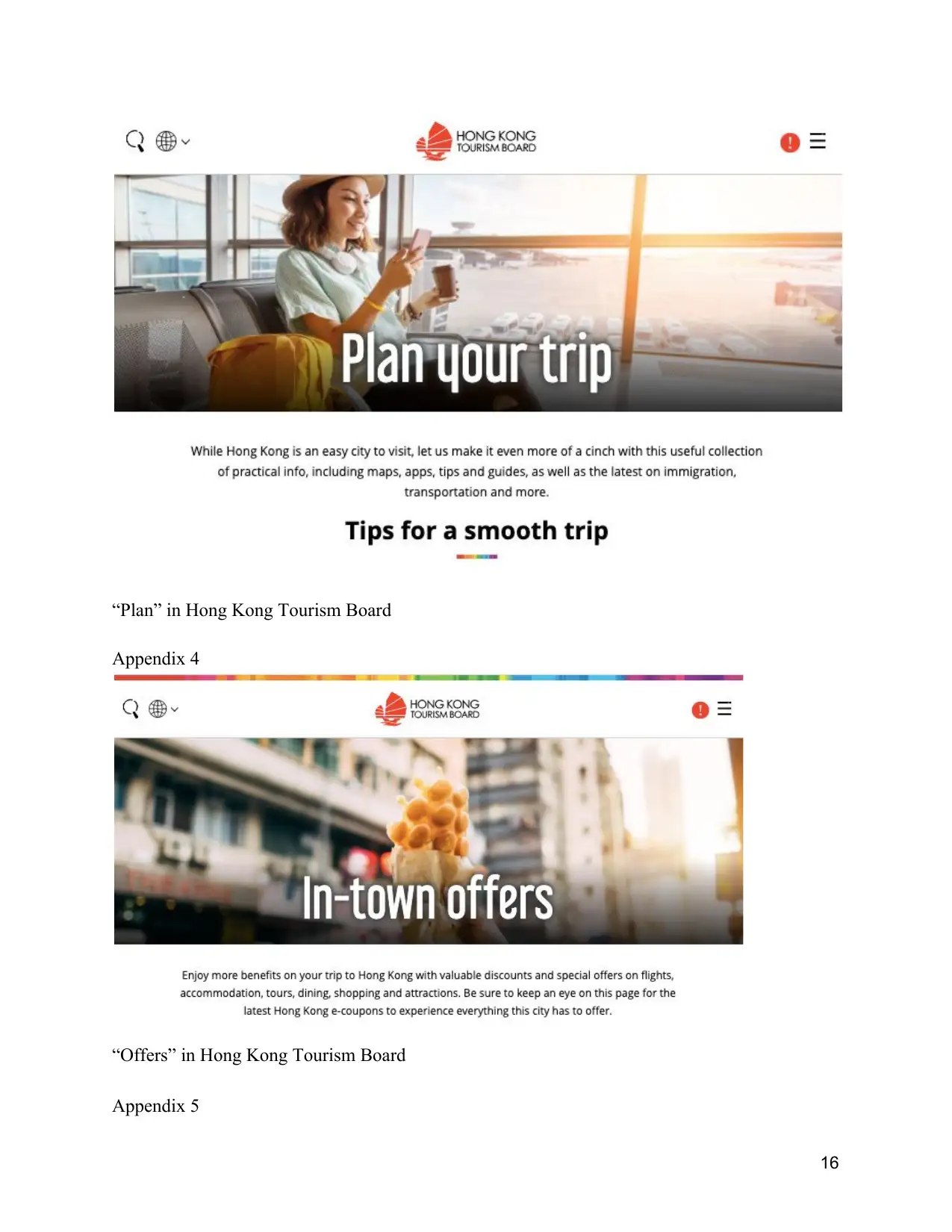
“Plan” in Hong Kong Tourism Board
Appendix 4
“Offers” in Hong Kong Tourism Board
Appendix 5
16
Appendix 4
“Offers” in Hong Kong Tourism Board
Appendix 5
16
Secure Best Marks with AI Grader
Need help grading? Try our AI Grader for instant feedback on your assignments.
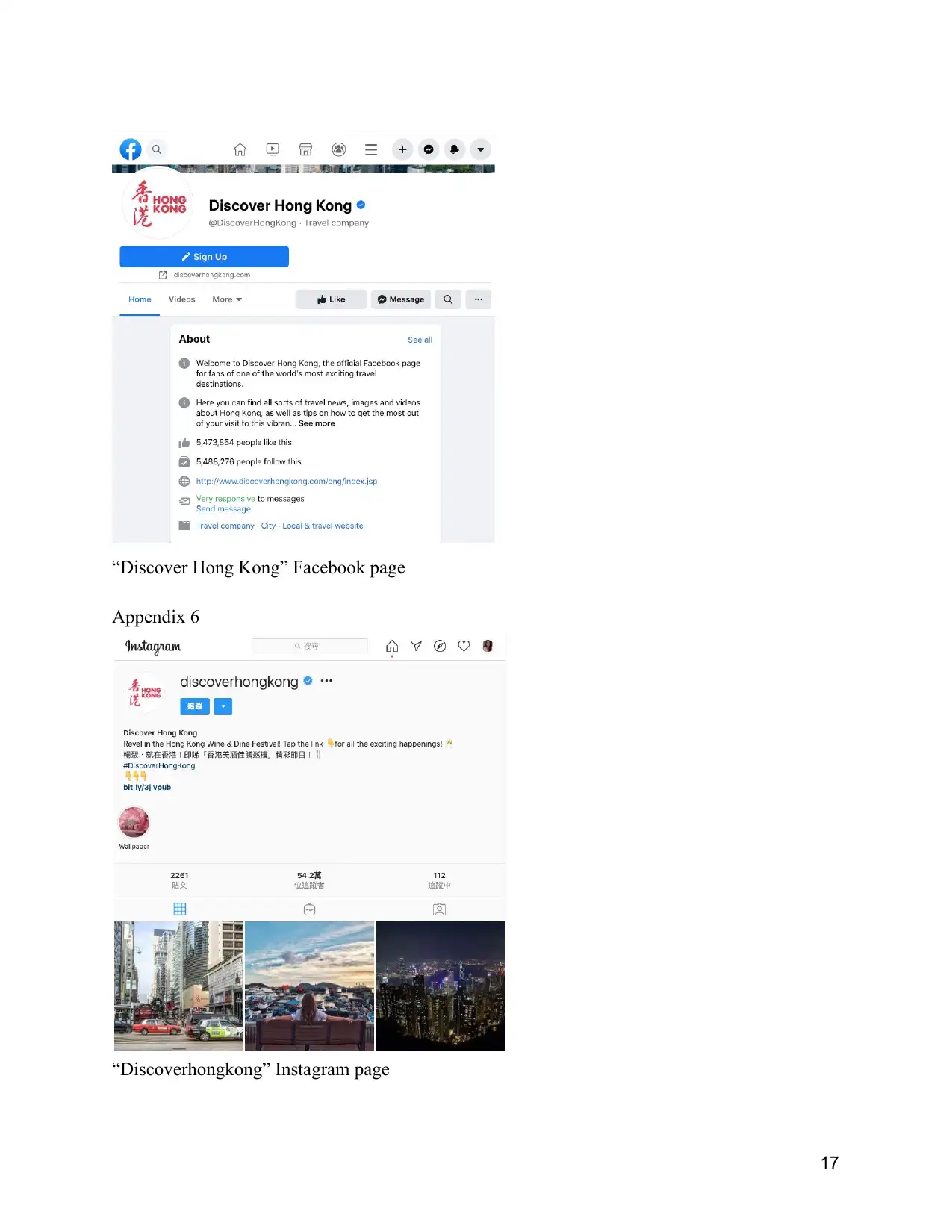
“Discover Hong Kong” Facebook page
Appendix 6
“Discoverhongkong” Instagram page
17
Appendix 6
“Discoverhongkong” Instagram page
17

Appendix 7
“Discover HK” Official twitter page of Hong Kong Tourism Board
Appendix 8
“Hong Kong” Youtube channel
18
“Discover HK” Official twitter page of Hong Kong Tourism Board
Appendix 8
“Hong Kong” Youtube channel
18

Appendix 9
19
19
Paraphrase This Document
Need a fresh take? Get an instant paraphrase of this document with our AI Paraphraser
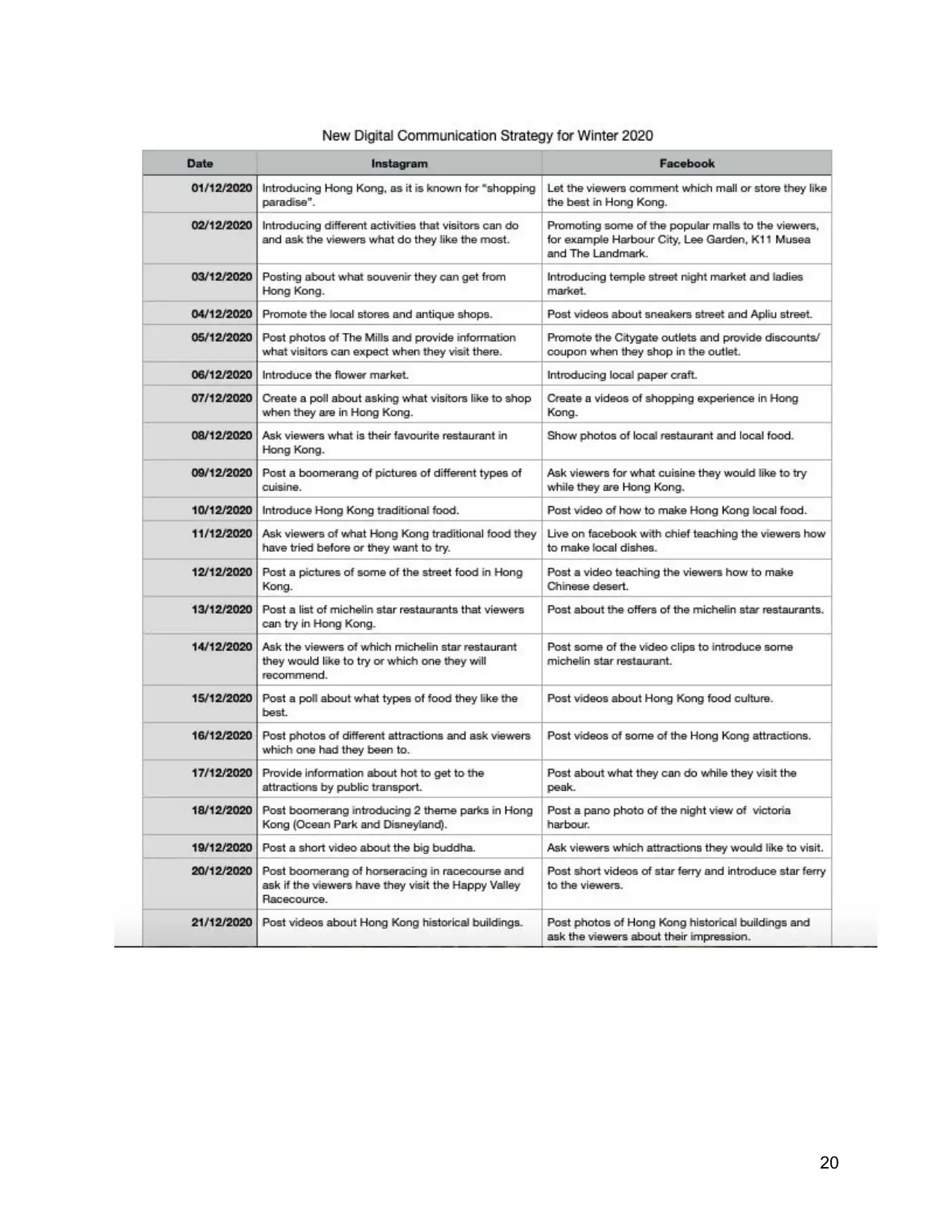
20

21
1 out of 21
Related Documents
Your All-in-One AI-Powered Toolkit for Academic Success.
+13062052269
info@desklib.com
Available 24*7 on WhatsApp / Email
![[object Object]](/_next/static/media/star-bottom.7253800d.svg)
Unlock your academic potential
© 2024 | Zucol Services PVT LTD | All rights reserved.




